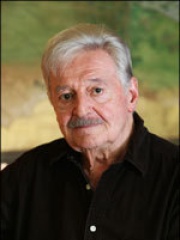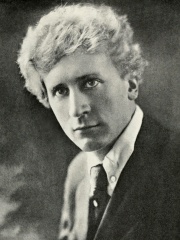



The Most Famous
COMPOSERS from Australia
Top 5
The following people are considered by Pantheon to be the most legendary Australian Composers of all time. This list of famous Australian Composers is sorted by HPI (Historical Popularity Index), a metric that aggregates information on a biography’s online popularity.

1. Peter Sculthorpe (1929 - 2014)
With an HPI of 55.42, Peter Sculthorpe is the most famous Australian Composer. His biography has been translated into 16 different languages on wikipedia.
Peter Joshua Sculthorpe (29 April 1929 – 8 August 2014) was an Australian composer. Much of his music resulted from an interest in the music of countries neighbouring Australia as well as from the impulse to bring together aspects of Aboriginal Australian music with that of the heritage of the West. He was known primarily for his orchestral and chamber music, such as Kakadu (1988) and Earth Cry (1986), which evoke the sounds and feeling of the Australian bushland and outback. He also wrote 18 string quartets, using unusual timbral effects, works for piano, and two operas. He stated that he wanted his music to make people feel better and happier for having listened to it. He typically avoided the dense, atonal techniques of many of his contemporary composers. His work was often characterised by its distinctive use of percussion. As one of the compositional pioneers of a distinctively Australian sound, Sculthorpe and his music have been likened to the role played by Aaron Copland in America's musical coming of age.

2. Percy Grainger (1882 - 1961)
With an HPI of 48.31, Percy Grainger is the 2nd most famous Australian Composer. His biography has been translated into 28 different languages.
Percy Aldridge Grainger (born George Percy Grainger; 8 July 1882 – 20 February 1961) was an Australian-born composer, arranger and pianist who moved to the United States in 1914 and became an American citizen in 1918. In the course of a long and innovative career he played a prominent role in the revival of interest in British folk music in the early years of the 20th century. Although much of his work was experimental and unusual, the piece with which he is most generally associated is his piano arrangement of the folk-dance tune "Country Gardens". Grainger left Australia at the age of 13 to attend the Hoch Conservatory in Frankfurt. Between 1901 and 1914 he was based in London, where he established himself first as a society pianist and later as a concert performer, composer, and collector of original folk melodies. As his reputation grew he met many of the significant figures in European music, forming important friendships with Frederick Delius and Edvard Grieg. He became a champion of Nordic music and culture, his enthusiasm for which he often expressed in private letters, sometimes in crudely racial or anti-Semitic terms. In 1914, Grainger moved to the United States, where he lived for the rest of his life, though he travelled widely in Europe and Australia. He served briefly as a bandsman in the United States Army during the First World War through 1917–18, and took American citizenship in 1918. After his mother's suicide in 1922, he became increasingly involved in educational work. He also experimented with music machines, which he hoped would supersede human interpretation. In the 1930s he set up the Grainger Museum in Melbourne, his birthplace, as a monument to his life and works, and as a future research archive. As he grew older, he continued to give concerts and to revise and rearrange his own compositions, while writing little new music. After the Second World War, ill health reduced his levels of activity. He considered his career a failure. He gave his last concert in 1960, less than a year before his death.

3. Arthur Benjamin (1893 - 1960)
With an HPI of 47.79, Arthur Benjamin is the 3rd most famous Australian Composer. His biography has been translated into 19 different languages.
Arthur Leslie Benjamin (18 September 1893 in Sydney – 10 April 1960 in London) was an Australian composer, pianist, conductor and teacher. He is best known as the composer of Jamaican Rumba (1938) and of the Storm Clouds Cantata, featured in both versions of the Alfred Hitchcock film The Man who Knew Too Much, in 1934 and 1956.

4. Malcolm Williamson (1931 - 2003)
With an HPI of 37.33, Malcolm Williamson is the 4th most famous Australian Composer. His biography has been translated into 16 different languages.
Malcolm Benjamin Graham Christopher Williamson, (21 November 1931 – 2 March 2003) was an Australian composer. He was the Master of the Queen's Music from 1975 until his death. According to Grove Music Online, although Williamson's earlier compositions aligned with Serialist techniques, "he later modified his approach to composition in the search of a more inclusive musical language that was fundamentally tonal and, above all, lyrical. In the 1960s he was commonly referred to as the most often commissioned composer in Britain, and over his lifetime he produced more than 250 works in a wide variety of genres."

5. Brett Dean (b. 1961)
With an HPI of 37.09, Brett Dean is the 5th most famous Australian Composer. His biography has been translated into 17 different languages.
Brett Dean (born 23 October 1961) is an Australian composer, violist and conductor.
People
Pantheon has 5 people classified as Australian composers born between 1882 and 1961. Of these 5, 1 (20.00%) of them are still alive today. The most famous living Australian composers include Brett Dean. The most famous deceased Australian composers include Peter Sculthorpe, Percy Grainger, and Arthur Benjamin.
Living Australian Composers
Go to all RankingsDeceased Australian Composers
Go to all RankingsPeter Sculthorpe
1929 - 2014
HPI: 55.42
Percy Grainger
1882 - 1961
HPI: 48.31
Arthur Benjamin
1893 - 1960
HPI: 47.79
Malcolm Williamson
1931 - 2003
HPI: 37.33
Overlapping Lives
Which Composers were alive at the same time? This visualization shows the lifespans of the 4 most globally memorable Composers since 1700.

